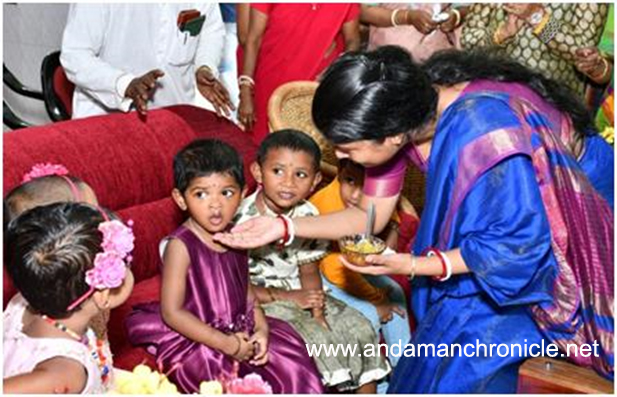
Port Blair, July 21: In compliance to the Government’s Millet Mission Policy to mainstream millets and to improve the nutritional diversity of the children by way of inclusion of millets- based recipes in the diet plan of Anganwadi Centres, before the full scale implementation in the Union Territory level for millet inclusion in the ICDS- SNP system, the Department of Social Welfare has proposed for one pilot programme, to be done for consensus building, feedback on feasibility and preference by the children before finalization of menus for AWCs. In addition, the menu suggested also pays special attention to the existing traditional food recipes and preferences pertaining to the different cultures. The need for such programme stems from the status of malnutrition among children in the Union Territory.
This pilot programme was launched by Smti Pallavi Sarkar, Secretary (Social Welfare), A&N Administration in a public function held at Atal Bihari Vajpayee Auditorium Rangat today. The core objective of the programme for inclusion of super foods millets along with other locally available nutritious food products is to provide diversity in terms of nutrition and taste, while fighting malnourishment and also to achieve the target of ‘Kuposhan Mukt’ village for all the villages and hamlets, thereby aiming for ‘Kuposhan Mukt A&N Islands’.
Addressing the gathering, the Secretary (Social Welfare) informed that the ‘Nutritional and Health Benefits of Millets’ published by the Indian Council of Agriculture in association with Indian Institute of Millet Research, Hyderabad (ICAR-IIMR) suggests that millets are not only comparable to major cereals with respect to their nutritional features, but are very good sources of carbohydrates, Micronutrients and photochemical with nutraceuticals properties. Millets contain 7-12 % protein, 2-5% fat, 65-75% carbohydrates and 15-20% dietary fibre. Among them, pearl millets contains considerably high proportion of proteins (12-16%) as well as lipids (4-6%) whereas; finger millet contains lower levels of protein (6-8%) and fat (1.5-2%). Finger millet is the richest source of calcium (300-350 mg/100 g) and other small millets are good source of phosphorous and iron. She requested all Anganwadi Workers to provide special attention for preparation of revised menu which should be tasty, healthy, presentable and acceptable to children and other beneficiaries.
The newly introduced millet based menu are Multigrain Laddu, Ragi Kheer and Bajra Khichdi which will be served to children from 6 months to 6 years, lactating and pregnant mothers registered in Anganwadi Centres.
The Adhyaksh, Zilla Parishad N&M Andaman, Shri Subrata Basu, Assistant Commissioner, Rangat, Smti Sapna Priya, Pramukh Rangat, Ms. Sita Majhi, Programme Officer, ICDS, Shri P.C James, CDPO Rangat, Smti V. Uma Devi & Head of Departments & Anganwadi Workers were present on the occasion.
During the launch programme, Anganwadi Workers presented different skits and cultural programmes depicting the importance of use of millets in daily menu for keeping a person healthy.